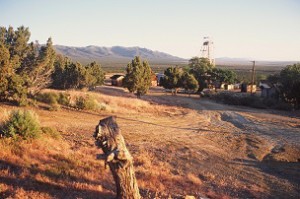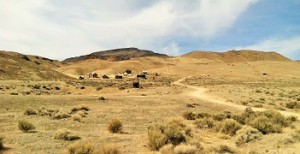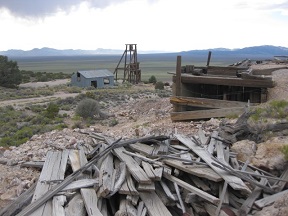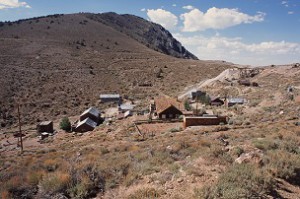 Relevant History welcomes Quinn Kayser-Cochran, who writes historic fiction set in the western U.S. and travels extensively throughout the West researching events, characters, and settings. His series follows a PTSD-afflicted veteran of the Philippine War who is a company detective in the mining camps of early 20th Century Nevada. The first novel, Glorieta, centers on the 1862 Confederate invasion of the New Mexico Territory. To learn more about Quinn’s fiction, check out his web site and follow him on Twitter.
Relevant History welcomes Quinn Kayser-Cochran, who writes historic fiction set in the western U.S. and travels extensively throughout the West researching events, characters, and settings. His series follows a PTSD-afflicted veteran of the Philippine War who is a company detective in the mining camps of early 20th Century Nevada. The first novel, Glorieta, centers on the 1862 Confederate invasion of the New Mexico Territory. To learn more about Quinn’s fiction, check out his web site and follow him on Twitter.
*****
In the late 19th Century, the Silver State was in trouble. Existential trouble. Since its discovery in 1859, Nevada’s Comstock Lode had produced staggering volumes of silver and gold, but its output peaked in 1877 (that year producing bullion worth nearly $800M at 2015 prices [1]) and thereafter dropped steadily. Without mining, what was left?
Timber, ranching, etc., employed relatively few. Gambling was widespread but accounted for just a fraction of Nevada’s economy. Slowly, Nevada hollowed out. The 1880 Census lists 62,262 residents, but just 42,335 in 1890, with five counties accounting for most of this diminished total.[2] More populous states resented this wasteland’s two Senatorial votes, and newspaper editors back East began calling for the revocation of Nevada’s statehood.
Sporadic strikes raised the state’s hopes, but few—such as Edgemont and Delamar, both in the 1890s—amounted to much once their shallow mineral deposits pinched out. Then in 1903, James L. Butler (according to eminent Nevada historian Sally Zanjani, more probably Tom Fisherman, a Shoshone Indian and possibly the state’s finest prospector) discovered an enormous silver deposit at Tonopah.[3] The resulting boom rekindled interest in Nevada’s mines, and waves of people and money followed.
Latecomers fanned out across the desert. Over the next two decades, strike followed strike: Rhyolite, Manhattan, Wonder, and, grandest of all, Goldfield (where, again, credit for discovery goes to Tom Fisherman [4]). The 1910 U.S. Census of Nevada lists 81,875 residents—proof that the state recovered all of its lost population and then some.
 What I find fascinating about this era is how the Old West and the new often collided. Staid Mormon colonies and wide-open mining camps existed within a few miles of each other; some towns ran on wood stoves and springwater while others had electric lights, water lines, and telephones; and mine owners and stockbrokers grew rich, while miners—lacking what we recognize today as basic workplace rights and safeguards—were maimed and killed at alarming rates. Add conflicting political and philosophical outlooks, Indian and race-related issues, and major cataclysms such as the Spanish-American War and the 1906 San Francisco earthquake, and it is apparent how tumultuous this era must have been.
What I find fascinating about this era is how the Old West and the new often collided. Staid Mormon colonies and wide-open mining camps existed within a few miles of each other; some towns ran on wood stoves and springwater while others had electric lights, water lines, and telephones; and mine owners and stockbrokers grew rich, while miners—lacking what we recognize today as basic workplace rights and safeguards—were maimed and killed at alarming rates. Add conflicting political and philosophical outlooks, Indian and race-related issues, and major cataclysms such as the Spanish-American War and the 1906 San Francisco earthquake, and it is apparent how tumultuous this era must have been.
Technology, Philosophy & Politics
 Nevada’s complex geology and relative isolation spurred technological innovations: square-set timbering—a system of interlocking timbers that enabled miners to span and support enormous voids inside the earth; braided-metal cables; and the use of compressed air-driven machinery, among others. After 1900, gasoline engines found use powering small mine hoists, and automobiles slowly began to supplant both railroads and horse-drawn wagons. Deep mines required vast reservoirs of capital to develop and operate, and owners went to great lengths to protect their returns.
Nevada’s complex geology and relative isolation spurred technological innovations: square-set timbering—a system of interlocking timbers that enabled miners to span and support enormous voids inside the earth; braided-metal cables; and the use of compressed air-driven machinery, among others. After 1900, gasoline engines found use powering small mine hoists, and automobiles slowly began to supplant both railroads and horse-drawn wagons. Deep mines required vast reservoirs of capital to develop and operate, and owners went to great lengths to protect their returns.
Some hired private detectives or convinced the governor to use Federal troops to suppress the Western Federation of Miners, whose members demanded safer working conditions and a share of the profits. Colorado’s 1904 labor wars resulted in an exodus of radicalized miners from that state, many of whom relocated to Nevada. Having seen firsthand what businessmen would do in order to protect their positions, they formed aggressive unions, ran their own candidates for public office, and battled with those they considered too rich and too out-of-touch for the health of the republic.
Setting
 Pedantic, I know, but I don’t like how movies and fiction usually portray frontier-mining camps. Anachronisms are blended into a pastiche of bat-wing saloon doors, gunfights, and prostitutes—closer to that era’s pulp novels than reality. The Nevada of my stories places mines and miners front and center.
Pedantic, I know, but I don’t like how movies and fiction usually portray frontier-mining camps. Anachronisms are blended into a pastiche of bat-wing saloon doors, gunfights, and prostitutes—closer to that era’s pulp novels than reality. The Nevada of my stories places mines and miners front and center.
Here’s an excerpt from my forthcoming novel Silver State that addresses some of the interplay between miners and company security:
…normal operations require miners to exit through change rooms up top. There, company officials watch ’em change out of their work clothes, looking for evidence of highgrading. Miners and their unions say it’s humiliating, having to strip in front of suspicious eyes, but the Association estimates that it’s reduced ore theft by more than eighty percent. I’ve worked shifts as a watchman in the change rooms, and let me tell you, the embarrassment and resentment are mutual.
Location, Appearance
 “Like a tin can, a mining camp often lies where it is thrown.”[5] This quote from a 19th-century newspaper editor suggests that camps were built where they could best support nearby mines (indeed, Nevada is dotted with “Old” and “New” versions of the same town—Reveille and New Reveille, old and new Fairview, and Old Bullion and New Bullion, et. al.—rebuilt once residents determined that the original locations were inconvenient to the mines). Movie sets, on the other hand, typically are built on flat land with mountains in the distance—no mines in sight. This is wrong.
“Like a tin can, a mining camp often lies where it is thrown.”[5] This quote from a 19th-century newspaper editor suggests that camps were built where they could best support nearby mines (indeed, Nevada is dotted with “Old” and “New” versions of the same town—Reveille and New Reveille, old and new Fairview, and Old Bullion and New Bullion, et. al.—rebuilt once residents determined that the original locations were inconvenient to the mines). Movie sets, on the other hand, typically are built on flat land with mountains in the distance—no mines in sight. This is wrong.
Boom & Bust
The archetype of a lonely prospector hoisting a gold nugget and shouting “Eureka!” was far outside most miners’ experiences. Most toiled for twelve-hour shifts in the smoky gloom of poorly-ventilated tunnels, drilling and blasting ore containing minerals invisible to the naked eye. Many companies—indeed, many camps—were just one bad month from oblivion. I’ve tried to inject some of that precariousness into Silver State:
Atop one rise, I stop, put the Welch in neutral, and set the hand brake—wedge rocks under the wheels for good measure, too. There’s a small mining camp just north of here and while I believe it’s deserted, I want to be sure. Taking binoculars, for several minutes, I lean across the hood and study a cluster of ramshackle buildings. Condensation from my breath keeps clouding the optics. Up on the hillside, though, no smoke rises from any stovepipe; no lights shining through the windows; no dogs or chickens in the yards. The camp’s a ghost. Nevada’s interior is full of little settlements like this, intermittently active according to the appetites of the smelter trusts; busy one year and completely deserted the next. Luckily for me, this is an off year.
Hopefully these details help evoke the gritty reality of Nevada’s 20th-Century mining camps.
Footnotes
1. Wikipedia, Comstock Lode, Later Years
2. Forstall, Richard L., Population of Counties by Decennial Census: 1900 to 1990, 3/27/95, All population figures quoted are from this document.
3. Zanjani, Sally, Goldfield, the Last Gold Rush on the Western Frontier, 1992, Swallow Press/University of Ohio Press, pp. 9-13. While traditionally, Harry Stimler and William Marsh are credited with Goldfield’s discovery, even these stories acknowledge that they were following up on Fisherman’s initial find.
4. Ibid.
5. Paher, Stanley W., Nevada’s Ghost Towns & Mining Camps, 1970, Nevada Publications, p. 257, Unattributed quote used in a photo caption.
*****
A big thanks to Quinn Kayser-Cochran. He’ll give away a $25 Amazon gift certificate to someone who contributes a comment on my blog this week. I’ll choose the winner from among those who comment by Friday at 6 p.m. ET.
**********
Did you like what you read? Learn about downloads, discounts, and special offers from Relevant History authors and Suzanne Adair. Subscribe to Suzanne’s free newsletter.

Thanks for giving us about the varying situations in mining camps and mine. History is too often depicted in simple terms.
Hollywood and politicians tend to simplify history. Nice to see you here again, Warren.
Thank you for commenting. I agree that a great many things from our past are filtered and/or forgotten. Resurrecting some of them is one of the pleasures of writing historical fiction.
Very interesting!
Thank you for reading and commenting.
Thank you for this information. One branch of ancestors were miners in Goldfield and Utah. I read a newspaper account about how one was trapped in a mine and later rescued. This helps supply background for it.
Thank you, Dottie. One of my college friends has ancestors who were killed in a mining accident in UT, and I’ve met other people who’s families were killed here in CO. It’s amazing to think what a free-for-all mining was before basic safety regulations were adopted. Even now it’s hazardous; back then it was more like Russian roulette.
And some types of mining were more hazardous than others.
I went looking for statistics to answer Suzanne’s last post but found conflicting information, so I’ll stick to annecdotes. Mining underground is, of course, more hazardous that placer or strip mining–I’d guess coal is the most dangerous, but maybe my perception is skewed by news reports out of China and Turkey about coal-dust explosions, collapsing tunnels, etc. If hardrock mining IS statistically less-deadly than coal mining, it can’t be too far behind. My novel, Silver State, is set largely in Delamar, NV, a hardrock camp where conditions were notoriously poor. Due to a lack of water, the ore there was dry-crushed, releasing clouds of dust not unlike powdered glass–silicosis among mine and mill workers was rampant. Following is an excerpt from Silver State where my protagonist considers conditions in the camp and their effect on its population:
I don’t know what to say. Miners lead hard lives—the toughest men I know earn their wages in the tunnels—and every camp has its share of accidents, but Delamar is altogether something else. This camp is a meat grinder that cuts men down in the prime of their lives. Look at Billy: been here about eighteen months and already silicosis has him gasping for air and contemplating his own death. Poor fellow can’t be thirty, yet he looks near to fifty. He came to us from the union’s conservative side: the majority who just want to put their heads down and work. Hours, wages, and breaks are their primary concerns—none of the Socialists’ bullshit, calling for the overthrow of capitalism and a redistribution of property. Guy just wants to take care of his family. Now look at him.